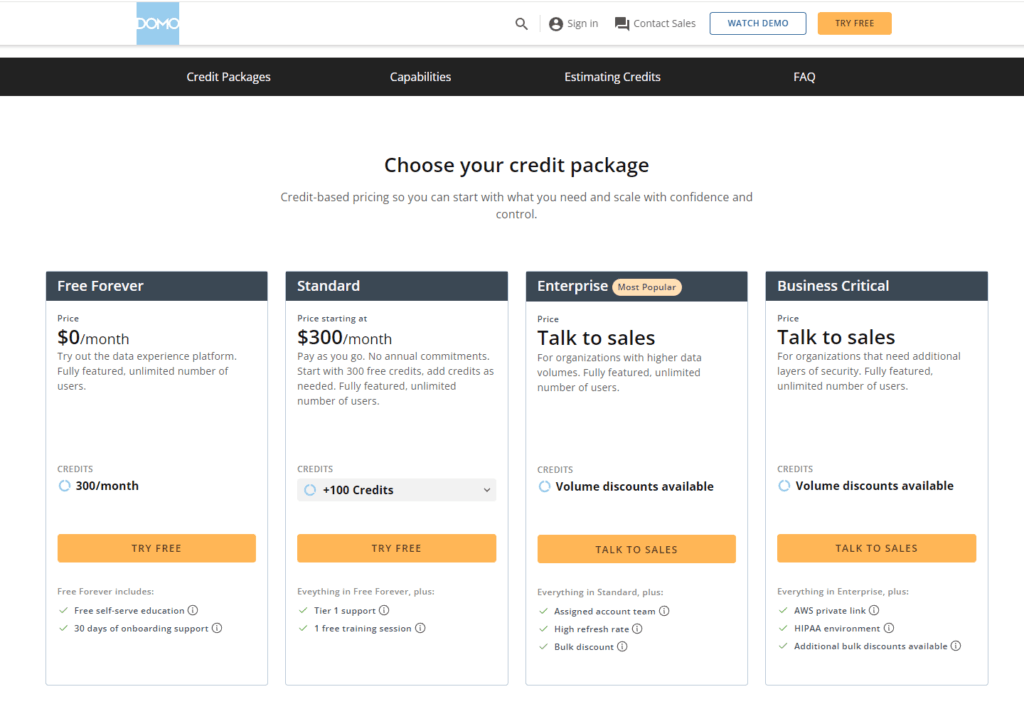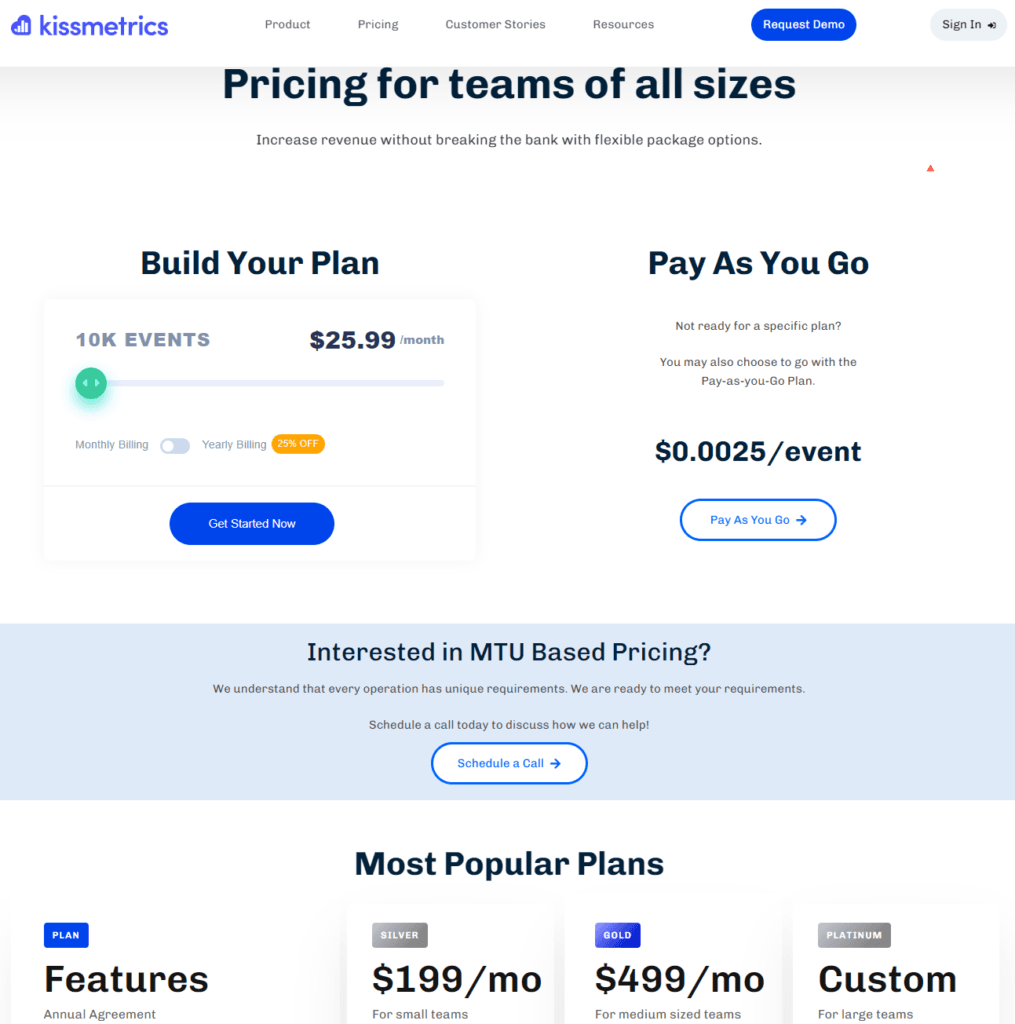In the digital era, where data drives decisions, the quest for the perfect analytics tool can feel like searching for a needle in a haystack. Enter the arena, Domo and Kissmetrics, two formidable contenders in the world of data analytics, each with its strengths and specialized capabilities. But which one is the right fit for your business needs? Is it Domo, with its broad enterprise focus and comprehensive data integration, or Kissmetrics, renowned for its customer-centric analytics and conversion tracking? Let’s embark on a journey to unravel the mysteries of these two platforms, starting with their approach to data integration.
| Domo | Kissmetrics |
|---|---|
 |  |
| G2 Score – 4.4 out of 5 stars | G2 Score – 4.1 out of 5 stars |
| TrustRadius Score – 8.5/10 | TrustRadius Score – 9.6/10 |
Integration Capabilities: The Gateway to Insights
The Heart of Data-Driven Decisions
In today’s fast-paced business environment, the ability to integrate data from multiple sources into a cohesive analytics platform is not just a luxury; it’s a necessity. Whether it’s sales data, customer interactions, marketing campaigns, or operational metrics, understanding how these pieces fit together is crucial for making informed decisions. Let’s delve into how Domo and Kissmetrics tackle the challenge of data integration, setting the stage for actionable insights.
Domo: Unifying Data with Ease
Domo positions itself as a conductor of the data symphony, offering an extensive suite of connectors that seamlessly integrate with a vast array of data sources. From cloud services and databases to social media platforms and CRM systems, Domo brings it all together in one unified view. This comprehensive approach to data integration allows businesses to break down silos, ensuring that every decision is informed by a 360-degree view of the organization’s data landscape.
Beyond mere aggregation, Domo shines in its ability to transform and enrich data, making it analysis-ready. Its platform empowers users to clean, merge, and prepare data with an intuitive, user-friendly interface, turning the complex process of data integration into a streamlined task. This capability ensures that businesses can focus on deriving insights rather than wrestling with data preparation.
Kissmetrics: Focused on Customer Journey Insights
While Domo offers broad integration capabilities, Kissmetrics takes a more focused approach, honing in on customer behavior and conversion data. Its strength lies in integrating data related to customer interactions across websites, apps, and other digital touchpoints. This specialization makes Kissmetrics an invaluable tool for businesses aiming to understand and optimize the customer journey from initial engagement to final conversion.
Kissmetrics excels in providing detailed insights into customer behavior, leveraging data from integrated sources to track conversions, engagement, and user retention. Its analytics are designed to help businesses identify trends, pinpoint bottlenecks in the conversion process, and understand the impact of marketing efforts on customer behavior. This focus on the customer journey enables businesses to tailor their strategies for maximum impact, driving growth through informed optimizations.
User Experience and Accessibility: Navigating the Data Landscape
Simplifying Complexity for All Users
A key challenge in data analytics is making complex data comprehensible and actionable for users across various roles within an organization. The ease with which users can navigate the platform, create reports, and extract insights plays a significant role in the tool’s adoption rate and the overall value it delivers to the business. Let’s examine how Domo and Kissmetrics address this challenge, enhancing the user experience to accommodate users of different skill levels.
Domo: Democratizing Data with Intuitive Design
Domo stands out for its commitment to democratizing data, offering an interface that balances depth of functionality with ease of use. It’s designed to serve a broad spectrum of users – from data scientists to marketing professionals – without overwhelming them with complexity. The platform achieves this through a highly intuitive interface, featuring drag-and-drop functionalities for creating custom dashboards and reports, and straightforward navigation that guides users to the insights they need.
Moreover, Domo emphasizes collaboration and accessibility, integrating features that allow users to share insights, communicate findings, and make collective decisions within the platform. This approach not only makes data more accessible across the organization but also fosters a culture of data-driven decision-making.
Kissmetrics: Specialized Focus on User Behavior Insights
Kissmetrics, with its focus on understanding and optimizing the customer journey, provides a user experience tailored to marketing teams and product managers. The platform simplifies the process of tracking user interactions, segmenting audiences, and analyzing the impact of different strategies on user behavior and conversion rates. This specialization ensures that users can quickly derive actionable insights without navigating through irrelevant data or features.
The strength of Kissmetrics lies in its ability to present complex customer behavior data in an understandable and actionable format. It offers pre-built reports and dashboards designed to highlight key metrics such as engagement, conversion, and retention, enabling users to assess the effectiveness of their efforts at a glance. This focus on delivering relevant insights ensures that marketing teams can make informed decisions rapidly, enhancing their ability to react to changing customer preferences and market conditions.

Related: Check out our free SEO suite

Customization and Flexibility: Shaping Tools Around Your Strategy
The Art of Tailoring Analytics
In the vast landscape of data analytics, the ability to customize the tool to suit specific business needs is what separates the good from the great. Customization encompasses everything from the ability to create bespoke reports and dashboards to tailoring data models and integration processes. Flexibility, on the other hand, refers to the platform’s adaptability over time as business needs evolve and grow. Let’s see how Domo and Kissmetrics stack up in offering customization and flexibility to their users.
Domo: The Chameleon of Data Analytics
Domo is celebrated for its chameleon-like ability to adapt to virtually any business environment. Its platform offers an impressive degree of customization, enabling users to create highly personalized dashboards and reports that align with specific business goals and metrics. Domo’s flexibility is evident in its wide array of connectors and APIs, which allow for seamless integration with a multitude of data sources, further enhancing its capability to mold to the organization’s existing tech stack.
Furthermore, Domo provides users with robust data transformation tools, empowering them to manipulate and prepare data in ways that suit their unique analytical processes. This combination of extensive customization options and flexibility makes Domo a powerful ally for businesses of all sizes, looking to embed data analytics deeply into their operational and strategic frameworks.
Kissmetrics: Focused Customization for Marketing Optimization
Kissmetrics, with its sharp focus on marketing analytics and customer behavior insights, offers customization features that cater specifically to the needs of marketing teams and product managers. The platform allows for the creation of custom reports and dashboards that highlight key metrics related to user engagement, conversion, and retention. This degree of customization is designed to surface actionable insights that directly inform marketing strategies and product improvements.
While Kissmetrics might not offer the broad customization capabilities of a platform like Domo, its strength lies in the targeted flexibility it provides to users focused on optimizing digital customer experiences. The platform’s data model is inherently designed to support detailed analysis of customer journeys, enabling users to tailor their analytical views to uncover the most relevant insights for driving growth through enhanced user engagement.
Scalability and Performance: Sustaining Growth with Data
Ensuring Future-Proof Analytics
As businesses evolve, so do their data analytics needs. Scalability ensures that an analytics platform can accommodate growth in data volume, complexity, and the number of users, without degradation in performance. Performance, on the other hand, is about the speed and efficiency with which the platform processes data and generates insights, which is critical for timely decision-making.
Domo: Engineered for Enterprise Growth
Domo is designed with scalability at its core, catering to the expansive needs of enterprise-level organizations. It offers a cloud-based platform that seamlessly scales to handle large volumes of data from various sources, supporting a growing number of users across different departments. Domo’s architecture is built to ensure that as businesses scale, access to real-time insights remains uninterrupted, enabling organizations to maintain agility in decision-making processes.
In terms of performance, Domo prides itself on delivering fast data processing capabilities, ensuring that users can access insights when they need them. The platform’s efficient data management system minimizes latency, providing a smooth user experience even as the complexity and volume of data analytics tasks increase. This combination of scalability and high performance makes Domo a robust solution for organizations planning for long-term growth and data-driven evolution.
Kissmetrics: Tailored for Marketing Scale
While Kissmetrics may not target the broad enterprise market to the same extent as Domo, it offers significant scalability within its niche of marketing analytics and customer behavior insights. The platform is designed to grow with your business, easily handling increasing amounts of customer data as your marketing efforts expand. This focus ensures that marketers can continue to derive detailed insights into user behavior and campaign performance, even as the scale of operations grows.
Kissmetrics also emphasizes performance, particularly in the context of real-time analytics. The platform’s ability to quickly process customer interaction data and generate actionable insights is key for marketers looking to adjust strategies on the fly. Though it might cater to a more specific audience, Kissmetrics demonstrates a strong commitment to scalability and performance, ensuring that marketing teams have the tools they need to drive growth effectively.
Pricing and Value Proposition: Balancing Cost with Insights
Assessing the Investment in Analytics
In a market flooded with analytics tools, understanding the pricing model and the value proposition of each option becomes paramount. Businesses must consider not only the upfront cost and ongoing expenses but also the potential ROI in terms of improved decision-making, operational efficiency, and competitive advantage. Let’s delve into how Domo and Kissmetrics stack up in this regard.
Domo: Comprehensive Analytics at a Premium
Domo is recognized for its comprehensive suite of analytics tools, designed to cater to a wide array of business intelligence needs across an organization. Its pricing model is tailored to the scale and scope of the business’s requirements, often resulting in a higher upfront investment compared to more specialized tools. This premium pricing reflects Domo’s broad capabilities, from data integration and visualization to collaboration and mobile access, offering a one-stop solution for enterprise-level analytics.
The value proposition of Domo lies in its ability to consolidate disparate data sources into a single platform, offering real-time insights that can inform strategic decisions across the entire organization. For businesses that can leverage the full spectrum of Domo’s capabilities, the ROI can be substantial, manifesting in enhanced data-driven decision-making, improved operational efficiencies, and a competitive edge in the market.

Kissmetrics: Focused Analytics with Clear Pricing
Kissmetrics presents a different approach, focusing specifically on marketing analytics and customer behavior insights. Its pricing model is more straightforward, with tiered plans that cater to businesses of different sizes, from startups to larger enterprises. This clarity in pricing makes it easier for businesses to understand their potential investment and align it with their analytics needs.
The value proposition of Kissmetrics is centered on its ability to provide deep insights into customer behavior, conversion tracking, and campaign effectiveness. For businesses focused on optimizing their marketing efforts and improving customer engagement, Kissmetrics offers targeted analytics that can directly impact revenue growth and customer retention. The ROI from using Kissmetrics can be highly significant for these businesses, particularly in terms of increased marketing efficiency and more effective customer journey optimization.

Conclusion
Domo emerges as a robust, all-encompassing analytics powerhouse, designed to cater to the vast and varied demands of enterprise-level analytics. Its strength lies in its ability to unify disparate data sources into a cohesive, real-time analytics environment, supporting data-driven decision-making across the entirety of an organization. Domo’s scalability ensures that it grows alongside your business, offering a premium solution that, while potentially commanding a higher investment, promises substantial returns in operational efficiency, strategic agility, and market competitiveness.
Kissmetrics, with its focused approach, shines in the realm of marketing analytics and customer behavior insights. It offers a clear and straightforward pricing model that aligns with the needs of businesses dedicated to optimizing their marketing efforts and enhancing customer experiences. For companies where marketing efficiency and understanding the customer journey are paramount, Kissmetrics provides targeted insights that can directly influence revenue growth and customer engagement strategies.
Read Next:





















